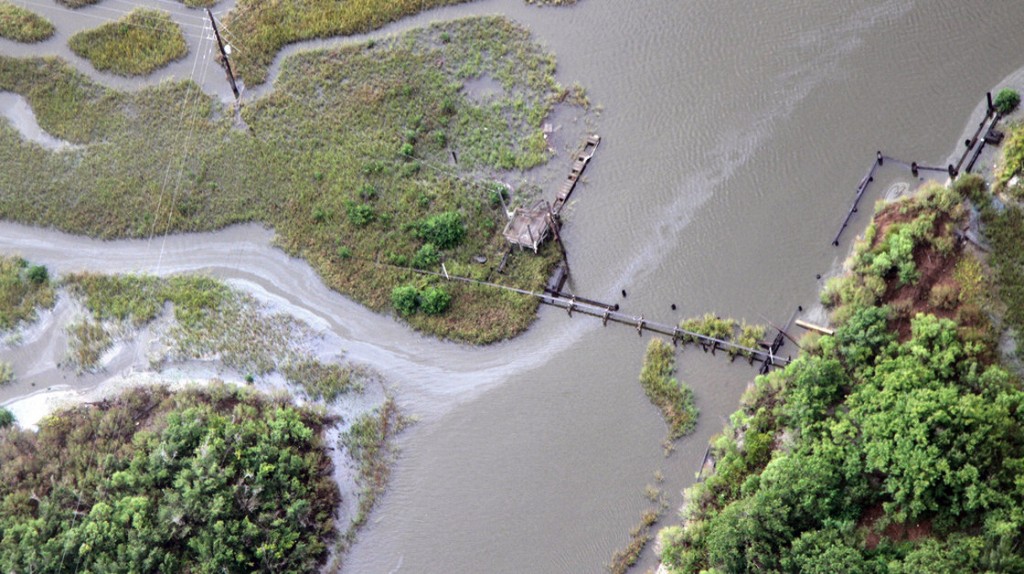http://www.npr.org/2014/04/19/304707516/telltale-rainbow-sheens-show-thousands-of-spills-across-the-gulf
by BOB MARSHALL
April 19, 201411:07 AM ET
Listen to the Story
Weekend Edition Saturday

The 300,000 wells drilled in Louisiana are connected by tens of thousands of miles of pipelines that are vulnerable to leaks, like this one in a coastal marsh. Gulf Restoration Network
Jonathan Henderson of New Orleans-based Gulf Restoration Network is flying Louisiana’s coast looking for oil. As usual, he’s found some. Just in the last year, I have filed 50 reports for different leaks and spills unrelated to the BP disaster.- Jonathan Henderson, Gulf Restoration Network. “I just noticed something out of the corner of my eye that looks like a sheen that had some form to it,” he says. “We’re going to go take a closer look and see if there’s a rainbow sheen.”
It’s a target-rich environment for Henderson, because more than 54,000 wells were planted in and off this coast – part of the 300,000 wells in the state. They’re connected by thousands of miles of pipelines, all vulnerable to leaks. And leak they do. Louisiana admits to at least 300,000 barrels spilled on its land and in its waters each year, 20 percent of the nation’s total. But those figures come from a system that depends largely on oil companies to self-report.
The problem went mostly unnoticed until the largest spill in U.S. history back on April 20, 2010, drew environmental groups to the coast looking for BP’s oil. “I started noticing, towards the end of 2010, other leaks that were unrelated to the BP disaster,” Henderson says. “I would find wellheads that were leaking or platforms that were leaking. Just in the last year, I have filed 50 reports for different leaks and spills unrelated to the BP disaster.”
Under the Clean Water Act, when a company spills any amount of oil in the water, it must file a report with the National Response Center run by the Coast Guard. But when Henderson checked, he found many of those smaller spills were not making that list. So environmental groups formed the Gulf Monitoring Consortium to get a better count on spills. The partnership is a blend groups of complementary skills.
Gulf Restoration Network, for example, has personnel who can spot spills from the air and file complete reports. SouthWings, a group of volunteer pilots, helps get those spotters aloft. A third member, the West Virginia-based tech group SkyTruth, finds the spills on satellite photographs, then applies a formula used by spill experts to translate the size of the oil sheen into gallons of oil in the water.
SkyTruth spokesman David Manthos says its estimates typically are much higher than what’s been reported. “We found that the spill was usually 10 times larger than had been reported, and that was averaged out across a lot,” he says. “In some, the mismatch was much larger than that.”
The sheer size of the industry here means there’s seldom a quiet day for the consortium. In an average year, the NRC receives 10,000 reports of spills in the Gulf.
It’s a number that surprised even SouthWings Gulf Program Director Meredith Dowling, a veteran of monitoring efforts. “I can’t think of a single instance where our volunteers have flown offshore and not found spills,” Dowling says. “This was something that was really amazing to me when I first moved here … that is was a continuous, absolute failure of business-as-usual practices.”
The partners hope their work educates the public to the scope of the problem, and perhaps gets governments to end the voluntary compliance model and turn to aggressive enforcement by outside groups.
Bob Marshall reports on the environment for The Lens, a New Orleans non-profit newsroom.

Louisiana relies largely on the oil industry to self-report leaks and spills. The Gulf Monitoring Consortium was formed to improve that effort and said it often finds smaller leaks like this one, near Golden Meadow, that go unreported by the companies.
Gulf Restoration Network

The vast oil insfrastructure in Louisiana’s wetlands are vulnerable to damage during hurricanes. These facilities were leaking after Hurricane Isaac.
Gulf Restoration Network
Special thanks to Richard Charter